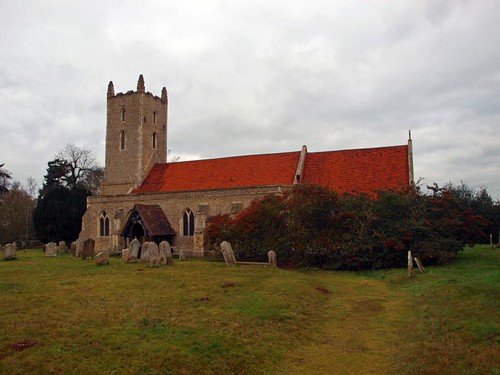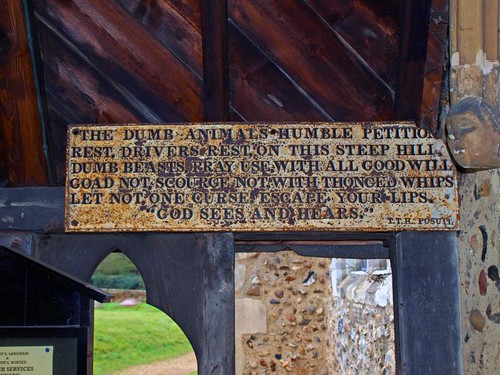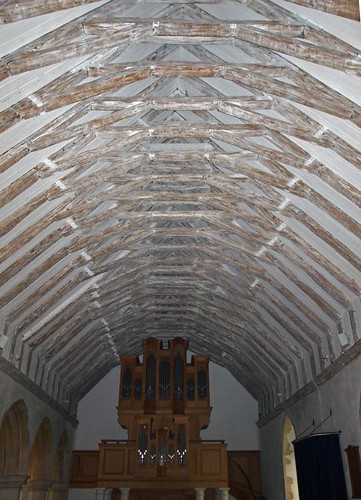ST MARY. The church lies right in a wood with only Church Farm (timber-framed, C17) nearby and Langham Hall (plain, c. 1740) at a distance. Norman nave, now only recognizable by the NE quoins of Roman bricks. The one small N window looks all new but may be renewed correctly. Later C13 W tower with later diagonal buttresses, battlements with crocketed pinnacles, but cusped lancet windows. C14 S aisle with low six-bay arcade of octagonal piers and double-chamfered arches. The windows of the aisle are also of the C14, the E window of an unusual variety: straightheaded, of five lights with slender ogee heads. In the S wall a recess with three heads, two as label-stops, one as keystone in the apex. The chancel is C14 too, see for example the reticulated tracery of the E window. - BENCHENDS. With poppy-heads, two with angel figures. - INSCRIPTION in the porch, mid C19, cast iron, no doubt not in situ:
The Dumb Animals Humble Petition.
Rest Drivers rest on this steep hill,
Dumb Beasts pray use with all good will.
Goad not, scourge not, with thonged whips,
Let not one curse escape your lips.
God sees and hears.
MONUMENT. Margaret Maud d. 1853, with sarcophagus and soul soaring up. By Manning of London.
He had been to school at Dedham, a mile or two away, and was friendly with John Fisher, the rector here, who offered to make him schoolmaster in the village. He is said to have painted one of his pictures of the lovely Stour valley from this tower; and it was another John Fisher, a nephew of the kindly rector, who became one of his lifelong friends.
The tower was ancient when Constable first saw it, for it was begun in the 13th century, carried up in the 14th, and completed with a brick parapet and pinnacles by Tudor builders. The nave has Roman bricks used again by the Normans, and the chancel a little pointed window of about 1200. The interior is dominated by the work of the 14th century men, from its nave roof to its arches and many of its windows. They fashioned the tomb recess with its three quaint heads, and the grotesque monsters with flowing manes on the little priest’s door. There are some coffin lids 700 years old, a timber almsbox possibly older, and two Tudor bench-ends richly carved with crowns and lions and solemn angels. A modern lychgate is touchingly dedicated to a mother in memory of her care and teaching; and among the church’s neighbours are Langham Hall, a modern house with old panelling on its walls inside, and Church Farm, a 17th century house with a two-storeyed porch.
One of the most delightful houses hereabouts is Valley House of the 16th century, with a staircase wing and a most attractive porch added a few decades later. The porch has four big brackets carved with spiral ornament, and the staircase is fine with exquisite balusters, rich newel posts, a series of carved vases, and a quaint figure of a woman. Not soon forgotten is Valley House, with its buttresses and windows and triple chimney-stacks, all making a fine array.
Simon K -
Open. An idyllic setting, and so pretty and remote after the last tourist spot. I am greeted by Jerry, the church cat, and what I took to be his brother. They are obviously well used to greeting hikers through the Dedham Vale who stop here for lunch! A sign on the door asks you to make sure that Jerry is not left inside when you leave the church, as 'he can't reach the handle'.
Incidentally, I believe that Langham is one of just two placenames found in all three counties of Norfolk, Suffolk and Essex. The other is the less surprising Sutton.
Flickr.



No comments:
Post a Comment